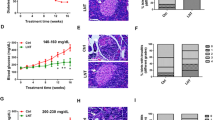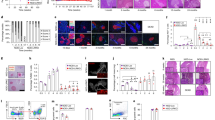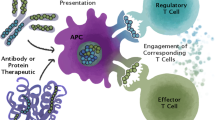Abstract
Previous studies have demonstrated that antigen-specific tolerance could be induced by lipopolysaccharide (LPS)-stimulated B cells retrovirally transduced with an immunoglobulin-antigen (or epitope-containing peptide) fusion construct. To investigate the mechanism of this gene therapy system, we now adapted this approach to immunotherapy of spontaneous diabetes in nonobese diabetic (NOD) mice, a T-cell-mediated autoimmune disease triggered, in part, by a pathogenic response to glutamate decarboxylase (GAD) 65. We demonstrate that LPS-stimulated splenocytes, retrovirally transfected with GAD-IgG fusion construct, induce a significant antigen-specific hyporesponsiveness at both cellular and humoral levels and reduce the incidence of diabetes in female NOD mice. Parallel with disease protection, we observed a prolonged increase of the numbers of CD4+CD25+ T cells in the periphery of GAD-IgG-treated mice, compared to those treated with a control IgG vector, both in the prediabetic period and persisting even 8 months after gene therapy. This increase appeared to be induced by the repeated stimulation of the antigen in the periphery instead of a result of differentiation of T-cell precursor in the thymus. Moreover, CD4+CD25+ T cells induced by GAD-IgG fusion construct were capable of suppressing the proliferative response of CD4+CD25− T cells in vitro; and ablation of the activity of CD4+CD25+ T cells by blocking antibody against CD25 could reverse GAD-specific T-cell hyporesponsiveness. These results suggested that CD4+CD25+ T-cell subset induced in GAD-IgG-treated NOD mice represented the regulatory or suppressive CD4+CD25+ T cells (Treg) and might play an important role in the induction and maintenance of tolerance in NOD mice. Furthermore, the numbers of splenic CD4+CD62L+ regulatory T cells in GAD-IgG-treated mice during the prediabetic period and serum TGF-β levels in 34–38-week-old GAD-IgG-protected mice were also increased, compared to control IgG-treated ones. Therefore, we propose that the induction of tolerance and the prevention of diabetes incidence in NOD female mice induced by the GAD-IgG fusion construct may require CD4+ regulatory T cells, and the possible mediation of TGF-β.
This is a preview of subscription content, access via your institution
Access options
Subscribe to this journal
Receive 12 print issues and online access
$259.00 per year
only $21.58 per issue
Buy this article
- Purchase on Springer Link
- Instant access to full article PDF
Prices may be subject to local taxes which are calculated during checkout






Similar content being viewed by others
References
Miller JFAP, Morahan G . Peripheral T cell tolerance. Annu Rev Immunol 1992; 10: 51–69.
Schwartz RH . A cell culture model for T lymphocyte clonal anergy. Science 1992; 248: 1349–1356.
Zambidis ET, Scott DW . Epitope-specific tolerance induction with an engineered immunoglobulin. Proc Natl Acad Sci USA 1996; 93: 5019–5024.
Zambidis ET, Barth RK, Scott DW . Both resting and activated B lymphocytes expressing engineered peptide-Ig molecules serve as highly efficient tolerogenic vehicles in immunocompetent adult recipients. J Immunol 1997; 158: 2174–2182.
Kang Y et al. Induction of hyporesponsiveness to intact foreign protein via retroviral-mediated gene expression: the IgG scaffold is important for induction and maintenance of immune hyporesponsiveness. Proc Natl Acad Sci USA 1999; 96: 8609–8614.
Agarwal RK et al. Retroviral gene therapy with an immunoglobulin-antigen fusion construct protects from experimental autoimmune uveitis. J Clin Invest 2000; 106: 245–252.
El-Amine M et al. Mechanism of tolerance induction by gene-transferred peptide-IgG fusion protein expressed in B lineage cells. J Immunol 2000; 165: 5631–5636.
El-Amine M, Hinshaw JA, Scott DW . In vivo induction of tolerance by an Ig peptide is not affected by deletion of FcR or a mutated IgG Fc fragment. Int Immunol 2002; 14: 761–766.
Melo ME et al. Gene therapeutic approaches to induction and maintenance of tolerance. Int Rev Immunol 2001; 20: 627–645.
Melo MEF et al. Gene transfer of Ig-fusion proteins into B cells prevents and treats autoimmune disease. J Immunol 2002; 168: 4788–4795.
Yoon J, Jun H . Cellular and molecular pathogenic mechanisms of insulin-dependent diabetes mellitus. Ann NY Acad Sci 2001; 928: 200–211.
Kaufman DL et al. Spontaneous loss of T-cell tolerance to glutamic acid decarboxylase in murine insulin-dependent diabetes. Nature 1993; 366: 69–72.
Tisch R et al. Immune response to glutamic acid decarboxylase correlates with insulitis in non-obese diabetic mice. Nature 1993; 366: 72–75.
Curotto de Lafaille MA, Lafaille J . CD4+ regulatory T cells in autoimmunity and allergy. Curr Opin Immunol 2002; 14: 771–778.
Read S, Powrie F . CD4+ regulatory T cells. Curr Opin Immunol 2001; 13: 644–649.
Wu AJ, Hua H, Munson SH, McDevitt HO . Tumor necrosis factor-α regulation of CD4+CD25+ T cell levels in NOD mice. Proc Natl Acad Sci USA 2002; 99: 12287–12292.
Shevach EM . CD4+CD25+ suppressor T cells: more questions than answers. Nat Rev Immunol 2002; 2: 389–400.
Herbelin A et al. Mature mainstream TCRαβ+CD4+ thymocytes expressing L-selectin mediate ‘active tolerance’ in nonobese diabetic mouse. J Immunol 1998; 161: 2620–2628.
Lepault F, Gagnerault MC . Characterization of peripheral regulatory CD4+ T cells that prevent diabetes onset on nonobese diabetic mice. J Immunol 2000; 164: 240–247.
Hill N, Sarvetnick N . Cytokines: promoters and dampeners of autoimmunity. Curr Opin Immunol 2002; 14: 791–797.
Roncarolo MG et al. Type 1 T regulatory cells. Immunol Rev 2001; 182: 68–79.
Weiner HL . Induction and mechanism of action of transforming growth factor-β secreting Th3 regulatory cells. Immunol Rev 2001; 182: 207–214.
Green EA, Choi Y, Flavell RA . Pancreatic lymph node-derived CD4+CD25+ Treg cells: highly potent regulators of diabetes that require TRANCE-RANK signals. Immunity 2003; 16: 183–191.
Pasare C, Medzhitov R . Toll pathway-dependent blockade of CD4+CD25+ T cell-mediated suppression by dendritic cells. Science 2003; 299: 1033–1036.
Nakamura K et al. TGF-β1 plays an important role in the mechanism of CD4+CD25+ regulatory T cell activity in both humans and mice. J Immunol 2004; 172: 834–842.
Acknowledgements
We thank Dr Jiannan Feng for generously providing the data of T-cell epitope prediction of GAD65. This work was supported by National Key Research and Development Programs on Fundamental Sciences (973 Project, 2001CB510005) and Hi-tech Research and Development Program of China (863 Project, 2001AA217061).
Author information
Authors and Affiliations
Rights and permissions
About this article
Cite this article
Song, L., Wang, J., Wang, R. et al. Retroviral delivery of GAD-IgG fusion construct induces tolerance and modulates diabetes: a role for CD4+ regulatory T cells and TGF-β?. Gene Ther 11, 1487–1496 (2004). https://doi.org/10.1038/sj.gt.3302327
Received:
Accepted:
Published:
Issue Date:
DOI: https://doi.org/10.1038/sj.gt.3302327
Keywords
This article is cited by
-
Non-myeloablative transplantation of bone marrow expressing self-antigen establishes peripheral tolerance and completely prevents autoimmunity in mice
Gene Therapy (2012)
-
Advances in the Field of Lentivector-based Transduction of T and B Lymphocytes for Gene Therapy
Molecular Therapy (2010)
-
B-Cell-Delivered Gene Therapy Induces Functional T Regulatory Cells and Leads to a Loss of Antigen-Specific Effector Cells
Molecular Therapy (2010)
-
Activated B cells in autoimmune diseases: the case for a regulatory role
Nature Clinical Practice Rheumatology (2008)
-
Foxp3-expressing CD4+T Cells Under the Control of IFN-γ Promoter Prevent Diabetes in NOD Mice
Molecular Therapy (2007)



